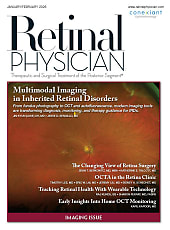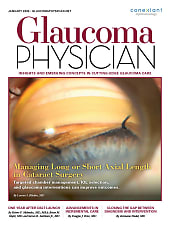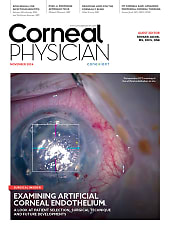Diversity, equity, and inclusion (DEI) is a term often used for principles and policies that aim to foster an environment where all individuals—irrespective of their race, gender, ethnicity, religion, or sexual identity—receive equal opportunities and access to resources and are valued for their unique perspectives and contributions. This is particularly important in health care, as studies have revealed general disparities in ophthalmology care based on racial and social determinants, including increased rates of endophthalmitis, diabetic retinopathy, cataract, ocular melanoma, and other issues.

Basil K. Williams Jr., MD, a vitreoretinal specialist and ocular oncologist, is associate professor of clinical ophthalmology at Bascom Palmer Eye Institute. As Bascom Palmer’s vice chair for diversity, equity, and inclusion, he leads initiatives to ensure diversity in recruiting, training, mentoring, and hiring within the field of ophthalmology.
In our conversation, which has been edited for length and clarity, he discusses how including DEI initiatives in ophthalmology may lead to better outcomes, particularly for historically marginalized communities.
New Retinal Physician: Last fall, during subspecialty day at the American Academy of Ophthalmology (AAO) meeting, you moderated a discussion on the importance of implementing DEI principles in ocular oncology to achieve better patient outcomes. Could you describe some of the data that you presented and ideas that were discussed?
Dr. Williams: We looked at things from a global standpoint initially, discussing retinoblastoma. There is a really good meta-analysis by Emily Wong that was published in Lancet in 2022; it looked at over 20,000 patients with retinoblastoma, dividing cases into 10-year increments from 1980 to 2020.1 Basically, what you see is that the survival rate and overall globe salvage has increased significantly in high-income countries, and in upper-middle-income countries as well. But in the lower-income countries, things have actually been pretty stagnant. There can be lower than a 50% survival rate in a lot of these low-income countries.
We often celebrate the advances that we’re making, but a disproportionate amount of patients that are diagnosed with retinoblastoma come from low-income countries, and we haven’t really made any progress in survival in that area.
The International Society of Ocular Oncology held its first meeting on the African continent in August 2023, in Kenya. It was a very powerful meeting, and we heard from a number of countries throughout Africa how they approach retinoblastoma and some of the challenges they have, as well as some of the things that they’re doing to increase awareness. They are tying screening to vaccines, because almost all of the kids in Africa are now getting vaccinated. So they train the nurses to do eye screens at that point, looking for leukocoria and other signs so that they’re able to catch retinoblastoma at that earlier stage.
One of the big takeaways from that meeting was that they needed to publish their data. That would help them work on reallocation of resources to make sure that their governments are funding retinoblastoma care. So it was a really powerful meeting to attend. That’s one way to impact some of the health disparities, at least on the African continent, but there was lots of valuable information and strategies to talk about for other low-income countries to approach this challenge.
NRP: The United States is considered an upper-income country, but you reported at AAO that there are similar problems here in terms of disparities in care.
Dr. Williams: A couple of studies have looked at ethnic, racial, and socioeconomic disparities for retinoblastoma care in the United States.2,3 They showed there is a higher rate of enucleation based on race in a lot of situations. There is even a difference in survival for retinoblastoma in the Black population, compared to White Americans.
A study on racial, ethnic, and socioeconomic disparities in retinoblastoma enucleation, published in the American Journal of Ophthalmology,3 found that:
• Almost three-fourths of retinoblastoma patients
in this study were enucleated.
• Nonwhite and Hispanic children are more likely
to be enucleated.
• Children of lower socioeconomic status are
more likely to be enucleated.
• Disparities in enucleation rates appear unrelated
to delayed diagnosis.
• Disparities in enucleation continue to persist
despite changing treatment patterns.
There are potentially a number of reasons why. Maybe it’s how early people show up to the physician; those who wait longer may have more advanced disease. This was looking at the SEER [Surveillance, Epidemiology, and End Results] database, so we don’t have all the granular details and it’s not a full representation of all patients in the United States, but I think it’s really valuable to see that there is a difference in outcomes.
We need to understand the implications of access to care, because maybe if we improve access to care, people will come in at an earlier time. There is some concern about socioeconomic status in terms of treatment with chemotherapy and how much that might cost vs enucleation being a “one-and-done” treatment. We’re not saying that enucleation is a bad treatment or knocking ophthalmologists or oncologists for having bias in their treatment decisions. But there are some discrepancies, and we need to better understand them in order to understand how we can fix them.
NRP: Does the data show similar effects for other ocular cancers in the United States? Are analysts finding similar disparities in care related to race, ethnicity, or other factors?
Dr. Williams: There’s data looking at race, ethnicity, and socioeconomic status in patients with uveal melanoma. There are differences in enucleation rates [patients of color are more likely to be enucleated], but no difference in survival.4 So maybe that’s related to [time of] presentation, or maybe it’s related to the fact that uveal melanoma is much less common in Hispanic and Black populations and therefore the diagnosis is harder to make. Or, maybe it’s an access to care issue.
Similar things are noted in the lymphoma world. We don’t have really good studies on intraocular or vitreoretinal lymphoma, but there is some data on central nervous system (CNS) lymphoma and there tends to be a pretty strong overlap between CNS lymphoma and primary vitreoretinal lymphoma. So if you use CNS lymphoma as a surrogate, you can actually see that there is a higher rate of disease in the Black population compared to the White population. Historically, there’s some association between CNS lymphoma and HIV, so we’re not sure how much of a component that may play in things. That’s something that needs to be better understood as well.
There’s a good analysis using the National Cancer Database that looked at 2,400 patients with ocular surface squamous neoplasia.5 It showed higher rates of death in patients who were male and Black, and that’s regardless of the tumor size, laterality, and other factors. It did not seem that there was an association with worse disease based on either male sex or Black race; the association was with difference in insurances. Black patients were more likely to be uninsured or more likely to be on Medicaid. Educational attainment also factored in.
You can see across a broad range of ocular oncology conditions that there are some disparities in care, in terms of the treatments that are administered, and sometimes in presentation of diseases, sometimes in survival, and so we really have to better understand the factors associated with this.
NRP: What steps can be taken to understand those factors?
Dr. Williams: I think in the grand scheme, what we need is to have better collaboration on data. One of the most meaningful things in our AAO presentation was looking at that analysis across the world for retinoblastoma. By pooling that data we were actually able to get meaningful information about where we’re going, from a progress standpoint. Collaboration to put together data is going to be really important. And then afterward, making sure that we mine this data and utilize it to help us change our resource allocation to focus on the best ways we can deliver better care.
Access to care is an important part of this. At AAO, a poster looked at the distribution of ocular oncologists across the country to see whether this affects people’s access to care. Turns out, ocular oncologists are primarily found in major cities. The poster did not go into much discussion about educational attainment, race/ethnicity, and other social determinants of health, but it does seem that patients in rural areas have a much larger distance to travel and that may impact the kind of care that they get.
We also talked at AAO about the importance of representation in leadership at meetings. I mentioned how the International Society of Ocular Oncology went out of its way to have its meeting on the African continent. We often think that all the advances in the United States and Europe are doing wonders for the field—but we’re also not listening and getting information from other parts of the world that are critical to us improving care for patients. So making sure we have representation from people of different countries that have different socioeconomic status and different patient challenges would be really important for the community as a whole. We can look at that in the United States as well, making sure we have broad representation from diverse populations so that the ideas and the conversations and the topics that we’re discussing are more applicable on a broad level.
That’s kind of the high-level overview. The disparities exist, they’re complex, they’re multifactorial, and so it’s not going to be something where we can easily come up with an answer. But as we work together we can hopefully figure out better ways to do this. We can get better access to care, put out better educational information, and go from there.
NRP: On a related note, there have been several studies related to DEI in healthcare in the United States published recently,6,7 including one coauthored by you.8 Can you share your observations on what the data from these studies is showing?
Dr. Williams: I actually think this is a huge component of delivering quality care. A number of studies have shown that people from the same racial and ethnic and gender background end up building stronger relationships that have better patient adherence to medication and better patient outcomes. That doesn’t mean that if you come from a different background you’re not able to relate to patients, but there is some meaningful level of connection when those things are aligned. I think this is really powerful.
In some [minoritized] communities there is a lack of trust in the healthcare system for various historical reasons. That can be hard to overcome. Having doctors who look like their patients, who understand and can relate to the daily challenges they face, can help build trust.
We obviously have to work on access to care and other challenges, but I do think diversity in the workforce plays a significant role in being able to build that strong relationship with patients and does play a role in the quality of care delivered.
NRP: How can the healthcare community eliminate or reduce barriers and increase diversity in the workforce?
Dr. Williams: At the current moment, there’s a lot of conversation about this. One step is to do more to let people of color coming into medical school know about ophthalmology as a field. It’s one of the specialties that many medical students do not get a lot of information about, and because ophthalmology is such a competitive field, a student who comes to it later may feel that they have not had enough time to build relationships or do enough research
in order to match.
In a lot of minoritized communities, there is also a heavy push to be a primary care physician so you can take care of large swaths of people. I think it’s important to explain that ophthalmology does do a lot of primary care work, and to stress the impact of vision on independence and quality of life. This can spur interest in the field at an earlier stage.
From a mentoring standpoint, the AAO has put together the Minority Ophthalmology Mentoring program, and the National Medical Association has the Rabb-Venable Excellence in Ophthalmology Research Program. Programs like these give people who come from minoritized backgrounds opportunities for mentorship and greater access to research opportunities. So that’s part of the solution: to increase interest in ophthalmology and access to opportunities, so more people are coming into the field.
There’s also the reverse perspective—the idea of “See it to be it.” It’s wonderful when young people have a number of role models from their community who are doing things like ophthalmology because that allows them to have the dream that they can also do it. It doesn’t seem so far-fetched when you see someone who looks like you, talks like you, prays like you—then you think, “Oh, this is something that I can also do.” It’s incumbent on academic institutions in particular to think about hiring practices, think about acceptance policies into residency, because those academic institutions are the main places where our trainees are seeing ophthalmologists. I think that encourages and inspires people.
We always want to make sure that we’re getting quality candidates. DEI is not about changing the requirements or lowering standards. But we also want to think about what makes a good ophthalmologist. Holistic application review, to make sure we’re understanding the person completely, can be really valuable. Looking at our admissions committees in residency and fellowships to make sure that they come from diverse backgrounds also allows us to view candidates differently.
It’s a really exciting time, and I do think as a field we are moving towards diversifying the workforce as well.
NRP: What advice or strategies would you give to a young retina surgeon or a young oncologist from a marginalized community as they’re trying to navigate their way into a career in ophthalmology?
Dr. Williams: I think now is among the best times ever to be going into ophthalmology and navigating these barriers, for a number of reasons. Post-COVID, the number of webinars and the availability of information and access has changed dramatically, so there’s a huge democratization of information now. If a medical school does not have an ophthalmology department, or a student feels isolated in their program because there’s not a lot of diversity, there are other ways they can gather information. There are a number of academic institutions that put their grand rounds online, that have academic curricula that is virtual, that they can learn from.
From a retina standpoint, Vit-Buckle Society and the American Society of Retinal Specialists (ASRS) provide lots of online information, as well as mentoring programs. There are ample opportunities to reach out to people in the subspecialty areas to ask for mentoring and guidance.
It’s no longer the case that if you’re in a program where you feel like you don’t have good mentorship, that means you don’t have opportunities. Simply reaching out to people who are running these programs opens a number of opportunities. Go to some of these meetings, like AAO, and you can make connections there as well.
NRP: These days, some people question the value of diversity, equity, and inclusion initiatives. How would you respond to those sorts of questions?
Dr. Williams: It’s really important to take a step back when thinking about this. Diversity in general brings a wider range of ideas, and allows a number of different solutions to problems. We also have to think about healthcare delivery for patients and if we’re thinking about giving patients the best care, we have to think about what their needs are. It is important to think about access to care, living environment, relationship with the healthcare system, relationship with the disease process, and functioning of family and social structures for different groups of patients. In this sense, equity is of paramount importance for the appropriate delivery of healthcare as different patients, based on who they are as an individual and their environment, need different things. By focusing on these individual patient needs, it is easier to appreciate the value of a diversified workforce, especially one in which all physicians are able to practice in an inclusive environment. That enhances patient comfort, increases patient compliance, broadens the perspectives of organizational and institutional leadership, and ultimately improves patient care.
If we view this through a patient-centric lens, with the goal of delivering the best care, then hopefully that will allow us to appreciate the value and benefit of diversity, equity and inclusion more broadly. NRP
References
1. Wong ES, Choy RW, Zhang Y, et al. Global retinoblastoma survival and globe preservation: a systematic review and meta-analysis of associations with socioeconomic and health-care factors. Lancet Glob Health. 2022;10(3):e380-e389. doi:10.1016/S2214-109X(21)00555-61. 1.
2. Yannuzzi NA, Francis JH, Marr BP, et al. Enucleation vs ophthalmic artery chemosurgery for advanced intraocular retinoblastoma: a retrospective analysis. JAMA Ophthalmol. 2015;133(9):1062-1066. doi:10.1001/jamaophthalmol.2015.2243
3. Rajeshuni N, Whittemore AS, Ludwig CA, Mruthyunjaya P, Moshfeghi DM. Racial, ethnic, and socioeconomic disparities in retinoblastoma enucleation: a population-based study, SEER 18 2000-2014. Am J Ophthalmol. 2019;207:215-223. doi:10.1016/j.ajo.2019.04.015
4. Shields CL, Kaliki S, Cohen MN, Shields PW, Furuta M, Shields JA. Prognosis of uveal melanoma based on race in 8100 patients: The 2015 Doyne Lecture. Eye (Lond). 2015;29(8):1027-1035. doi:10.1038/eye.2015.51
5. Zhang KY, Aurit S, Silberstein P. Racial and socioeconomic disparities in ocular surface squamous neoplasia: a National Cancer Database analysis. Ophthalmic Epidemiol. 2022;29(3):319-327. doi:10.1080/09286586.2021.1925307
6. Stanford FC. The importance of diversity and inclusion in the healthcare workforce. J Natl Med Assoc. 2020;112(3):247-249. doi:10.1016/j.jnma.2020.03.014
7. Woreta FA, Gordon LK, Knight OJ, Randolph JD, Zebardast N, Pérez-González CE. Enhancing diversity in the ophthalmology workforce. Ophthalmology. 2022;129(10):e127-e136. doi:10.1016/j.ophtha.2022.06.033
8. Aguwa UT, Williams BK Jr, Woreta FA. Diversity, equity, and inclusion in ophthalmology. Curr Opin Ophthalmol. 2023;34(5):378-381. doi:10.1097/ICU.0000000000000970








